Comments / Questions (77)
![]() Tiiu Karotam wrote:
Tiiu Karotam wrote:
Kui on kootud 15-16-17 (18-19) cm, koo maha mõlemal küljel 8-8-8 (10-12) s käeaugu jaoks (s.t 4-4-4 (5-6) s mõlemal pool mõlemat SM-i). Lõpeta esi- ja seljaosa eraldi. Kuidas tuleb teha see maha kudumine vasakult paremale? Ehk siis kui ma koon esiosa, esimeselt vardalt paremalt minnes koon 4 silma maha ja kui teise varda koos ja tahaks varda lõpust 4 silmust maha kududa, kuidas seda teen?
16.05.2015 - 20:23DROPS Design answered:
Soovitan maha kududa 8 s ühel küljel ja siis 8 s teisel küljel, siis jääb lõngajooks kenasti kas esi- või seljaosa jätkamiseks valmis.
28.07.2015 - 17:25
![]() Alice wrote:
Alice wrote:
Hi, I would like to knit the Viggo Vest as shown in the picture and would like to buy the wool and the buttons. Where could I get both? I have no problems finding a shop to get the wool from, but no where to get the buttons from. And I would like to get it all at the same time. Many thanks and kind regards Alice
22.04.2015 - 17:52DROPS Design answered:
Dear Alice, please click here to get the list of all retailers (stores and online shops) in U.K. - you will see also the ones who are selling our buttons. Happy knitting!
22.04.2015 - 18:46
![]() Deschatelets Andrée wrote:
Deschatelets Andrée wrote:
Bonjour! J'aimerais faire ce modèle en gris et olive taille 6-9 mois. Est-ce que je peux utiliser Drops Alpaca 517 et 7233 sans changer le patron? Je ne suis pas une experte. Merci!
28.01.2015 - 00:13DROPS Design answered:
Bonjour Mme Deschatelets, BabyAlpaca Silk et Alpaca sont toutes 2 du groupe A, vous pouvez donc utiliser ici Alpaca, dans les mêmes quantités (elles ont toutes les 2 le même métrage pour 50 g). Bon tricot!
28.01.2015 - 10:59
![]() Ina wrote:
Ina wrote:
Hallo! wenn ich nicht die Nadelstärke ändern, sondern alles in der gleichen Nadelstärke (z.B. 2,5) stricken möchte, muss ich dann gleich weniger Maschen für das Bündchen aufnehmen oder kann ich mich an die Anleitung halten und im Bündchen mehr, danach weniger Maschen verwenden? Vielen Dank!
23.01.2015 - 17:04DROPS Design answered:
Ich bin nicht ganz sicher, ob ich Sie richtig verstehe, passt Ihre Maschenprobe nicht und Sie möchten trotzdem mit Nadel 2,5 stricken? Umrechnen ist immer heikel, da sich dann der Schnitt ändert, Halsausschnitt und Armausschnitte stehen dann möglicherweise nicht mehr im richtigen Verhältnis. Oder möchten Sie einfach das Bündchen in derselben Nadelstärke wie den Rest stricken?
28.01.2015 - 10:33
![]() Laura wrote:
Laura wrote:
Hallo, ich bin jetzt soweit, dass ich nur noch das Bündchen ringsherum stricken muss. Wie bekomm ich dass denn jetzt so hin, dass es nicht komplett unordentlich aussieht? Beim Abketten sind ja schon kleinere Stufen entstanden. Gibt es da einen Trick, damit keine Löcher entstehen? Vielen Dank schonmal im voraus.
11.01.2015 - 11:59DROPS Design answered:
Wo man generell einsticht, um M aufzufassen, ist in den Videos ganz anschaulich dargestellt, die Sie neben dem Foto oben im Kopf unter "Videos" finden. Damit sollte sich auch das Problem der Lochbildung lösen, Sie können damit die Stufen auf der Rückseite des Pullis verschwinden lassen. Hilfreich ist auch, schon beim Abketten der M die Stufen zu verringern, indem man die abzukettende M am Ende der letzten R nicht strickt, sondern auf der Nadel liegen lässt und vorher wendet. Nach dem Wenden die 1. M der linken Nadel nur abheben und die 1. M der rechten Nadel überziehen.
11.01.2015 - 15:26
![]() Turi wrote:
Turi wrote:
Hej, først, tak for opskriften og hjemmesiden generelt. Godt til en nybegynder som mig. Mit spørgsmål drejer sig om det første man skal gøre efter at have strikket rib. Der står "...SAMTIDIG som der lukkes 38-42-46 (50-56) m af jævnt fordelt på 1.omg = 114-130-146 (162-176) m." Hvad betyder dette? Betyder det at jeg 'indsnævrer' bærestykket?
10.01.2015 - 23:41DROPS Design answered:
Hej Turi. Ribben traekker sig altid mere sammen en almindelig glatstrik, saa naar du er faerdig med den skal du tage ind jaevnt fordelt - dvs, du mindsker antallet af masker paa pinden. Det kan du f.eks. göre ved at strikke 2 m ret sammen. Det gentager du saa f.eks. i alt 38 gange paa den mindste str med en jaevn afstand (du har 152 m og skal tage 38 m ind = ca 3-4 m imellem hver indtagning). God fornöjelse.
12.01.2015 - 16:34
![]() Regina wrote:
Regina wrote:
Hallo, wie wird das Bündchen am Halsausschnitt mit den Schulterteilen und dem Rückenteil zusammengestrickt? Bei mir sind Schulterteil und Bündchen separat, hab ich etwas falsch gemacht?
04.03.2014 - 16:48DROPS Design answered:
Liebe Regina, Sie fassen alle M für die Bündchen immer aus den Rändern der einzelnen Teile auf (in der angegebenen Reihenfolge, d.h. die M für das Schulterbündchen werden zuletzt aufgefasst) und stricken kein Bündchen separat.
04.03.2014 - 19:55
![]() Lene Iversen wrote:
Lene Iversen wrote:
Jeg kan ikke få jeres målskema til at passe med, at jeg allerede skal lukke af til ærmer, når arbejdet måler 15 cm.
01.02.2014 - 20:35DROPS Design answered:
Hej Lene. Maalskema passer. Den totale höjde for str 1/3 mdr er 25 cm. Aermegabet er 10 cm = 15 cm til at lukke af for aermer.
04.02.2014 - 14:54
![]() Nina wrote:
Nina wrote:
Hejsa. Denne vest er bare lækker, særligt fordi den er relativt enkel. Jeg har strikket den i brun og grå, hvilket kan ses på min blog.
07.01.2014 - 20:56
![]() Viktoria wrote:
Viktoria wrote:
Hallo liebes Drops-Team. ich bin Anfängerin und habe mich trotzdem mal an die Weste gewagt. Nun die erste Hürde. Wenn in der Anleitung steht die Teile (vorder- und Rückenteil ) für sich fertig stricken. Was ist damit genau gemeint? Die Teile auf anderen Nadeln fertig stricken? Danke schonmal. Gruß Viktoria
18.12.2013 - 17:41DROPS Design answered:
Liebe Viktoria, das bedeutet einzeln fertig stricken. Sie können nacheinander die gleiche Nadel benutzen.
19.12.2013 - 07:37
Viggo#viggovest |
|
|
|
|
Knitted vest / slipover with stripes for baby and children in DROPS BabyAlpaca Silk
DROPS Baby 21-33 |
|
|
RIB: * K 2, P 2 *, repeat from *-*. STRIPES: * 2 rounds/rows pistachio, 2 rounds/rows light sea green *, repeat from *-*. -------------------------------------------------------- -------------------------------------------------------- BODY: Cast on 152-172-192 (212-232) sts on circular needle size 2 mm with light sea green Baby Alpaca Silk. Work in RIB - see explanation above - for 3-3-3 (4-4) cm. Switch to circular needle size 2.5 mm and work in stocking st and STRIPES - see explanation above - while AT THE SAME TIME dec 38-42-46 (50-56) sts evenly on 1st round = 114-130-146 (162-176) sts. Insert a marker at beg of round and a marker after 57-65-73 (81-88) sts = mid of each side. REMEMBER THE KNITTING TENSION! When piece measures 15-16-17 (18-19) cm, cast off 8-8-8 (10-12) sts in each side for armholes (i.e. 4-4-4 (5-6) sts on each side of both markers). Then finish front and back piece separately. BACK PIECE: = 49-57-65 (71-76) sts. Continue to cast off for armholes in each side as follows: 2 sts 3 times and 1 st 2-3-3 (5-4) times = 33-39-47 (49-56) sts. When piece measures 23-25-27 (29-31) cm, cast off the middle 19-21-25 (27-30) sts for neck and finish each shoulder separately. Continue to cast off 2 sts on next row from neck = 5-7-9 (9-11) sts remain on shoulder. Cast off when piece measures 24-26-28 (29½-31½) cm. FRONT PIECE: = 49-57-65 (71-76) sts. Continue to cast off for armholes in each side as on back piece. AT THE SAME TIME when piece measures 20-22-23 (25-26) cm, slip the middle 9-11-15 (17-20) sts on a stitch holder for neck and finish each shoulder separately. Continue to cast off for neck at beg of every row from neck: 2 sts 2 times and 1 st 3 times. After all cast offs and dec are done, 5-7-9 (9-11) sts remain on shoulder. Cast off when piece measures 24-26-28 (29½-31½) cm. FRONT NECK EDGE: Knit up from RS approx. 48-60-68 (72-80) sts incl sts on stitch holder at the front (divisible by 4) along the neck line at the front on circular needle size 2 mm with light sea green. Work rib back and forth on needle with 1 edge st in garter st and 2 K sts in each side (seen from RS). When neck edge measures 2-2-2 (3-3) cm, loosely cast off with K over K and P over P. BACK NECK EDGE: Knit up from RS approx. 36-40-44 (48-52) sts (divisible by 4) along the neck line at the back and work rib as on front piece. SLEEVE EDGE: Knit up from RS approx. 76-84-88 (96-104) sts (divisible by 4) along one armhole on circular needle size 2 mm with light sea green. Work rib back and forth as on neck edge. Repeat along the other armhole. FRONT SHOULDER EDGE: Knit up from RS along the front of one shoulder (also over sleeve and neck edge) approx. 20-24-28 (32-36) sts (divisible by 4) on circular needle size 2 mm with light sea green. Work rib back and forth with 1 edge st in garter st and 2 K sts in each side (seen from RS). When edge measures approx. 1-1.5 cm, cast off for 2 button holes. 1 button hole = cast off 2 sts and cast on 2 new sts on next row over these sts. Each button hole should be at least 3 sts from the edge in each side. When edge measures 2-2-2 (3-3) cm, cast off with K over K and P over P. Repeat at the front on the other shoulder. BACK SHOULDER EDGE: Knit up along the back of one shoulder as on front piece and work rib as on front piece but do not cast off for button holes. Repeat at the back on the other shoulder. Sew on buttons. |
|
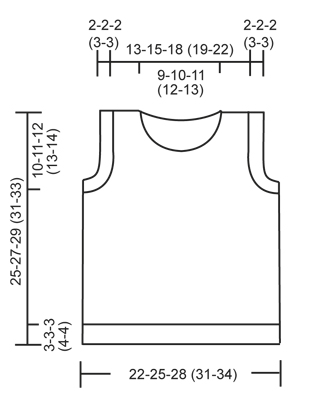 |
|
Have you finished this pattern?Tag your pictures with #dropspattern #viggovest or submit them to the #dropsfan gallery. Do you need help with this pattern?You'll find 10 tutorial videos, a Comments/Questions area and more by visiting the pattern on garnstudio.com. © 1982-2025 DROPS Design A/S. We reserve all rights. This document, including all its sub-sections, has copyrights. Read more about what you can do with our patterns at the bottom of each pattern on our site. |








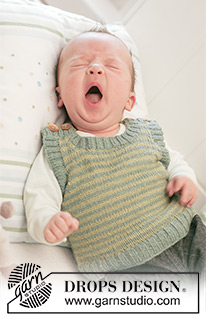
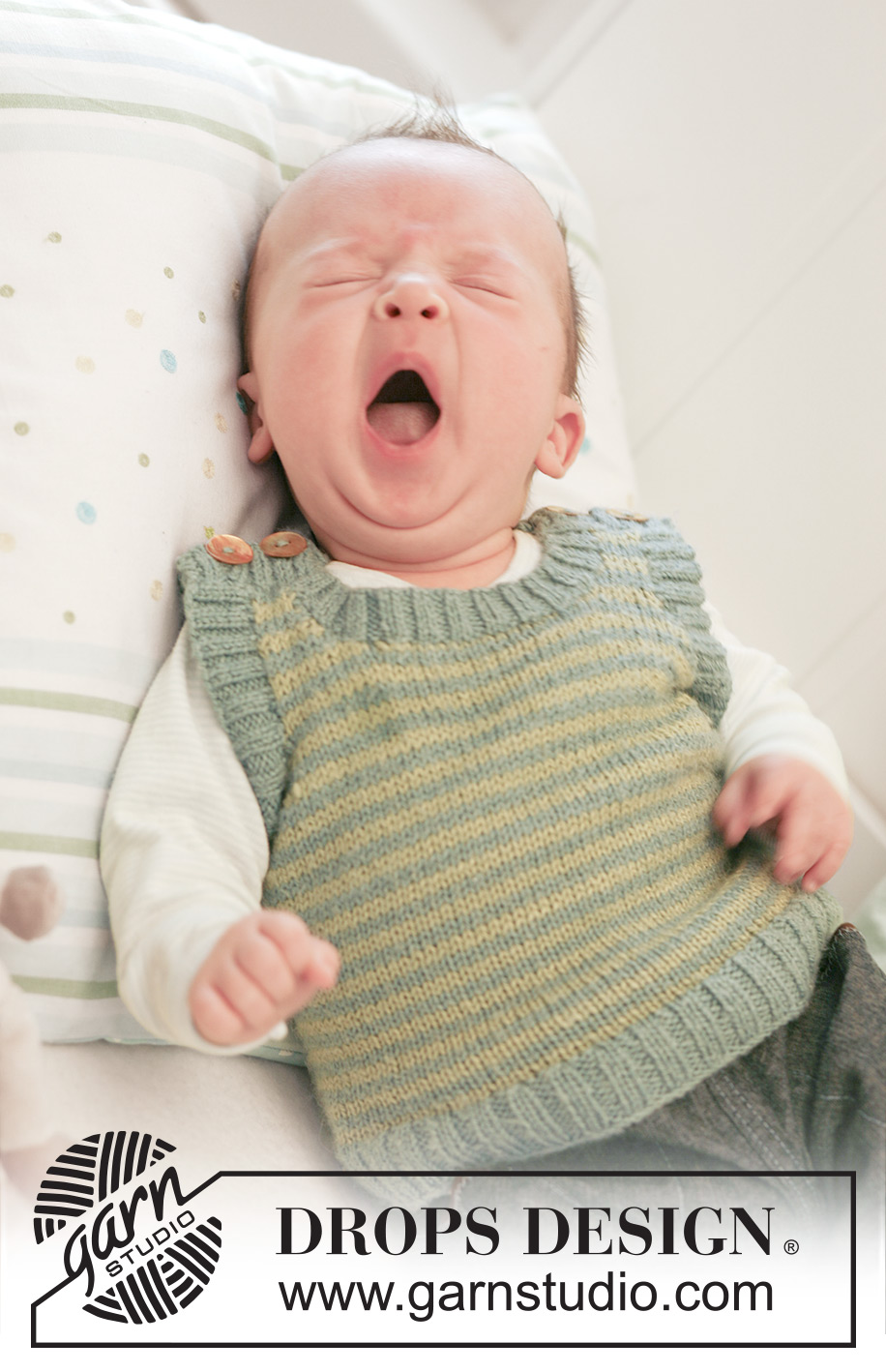
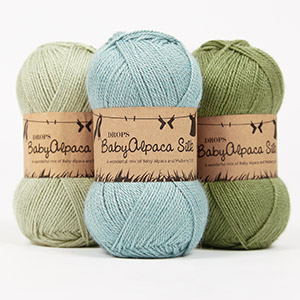
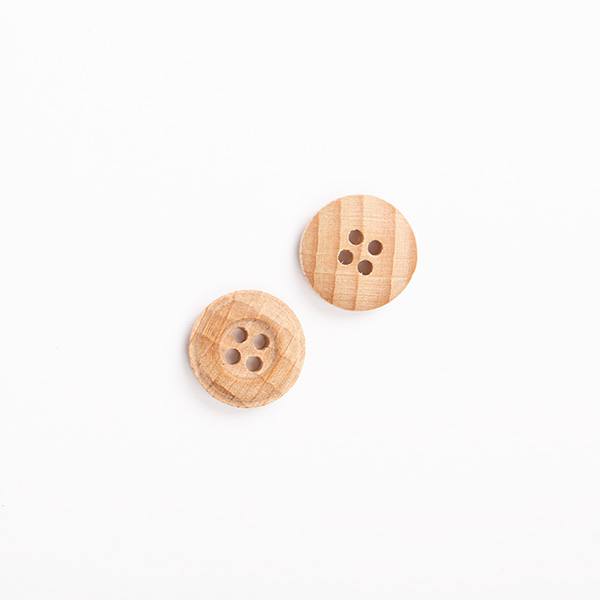




























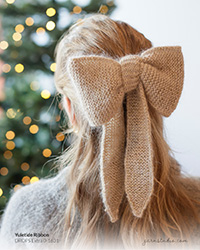
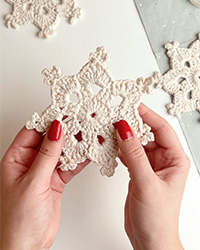
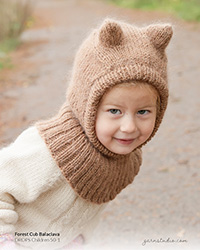
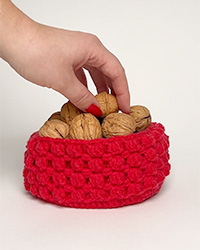
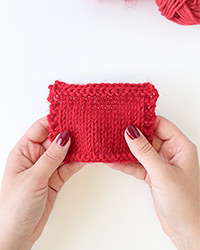

Post a comment to pattern DROPS Baby 21-33
We would love to hear what you have to say about this pattern!
If you want to leave a question, please make sure you select the correct category in the form below, to speed up the answering process. Required fields are marked *.